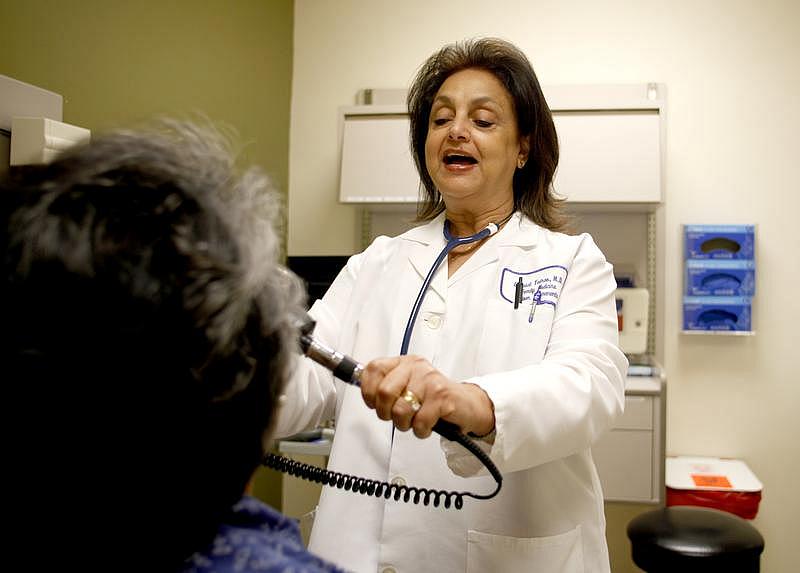Importing Doctors: Pace of foreign-physician influx may slow
California fellow Kellie Schmitt completed a multi-piece series on why the United States relys on foreign doctors.
Part One: More than half of Kern physicians were foreign-schooled
Part Two: Are we creating a foreign brain-drain
Part Three: Pace of foreign-physician influx may slow
Part Four: KMC's multimillion dollar deal with Caribbean school marks part of controversial trend
Part Five: Concerns about the quality of Caribbean schools persist
Part Six: Many American students turn to Caribbean medical schools

A simple math equation explains why the United States imports so many foreign doctors: it needs more physicians than it produces.
The country bridges some of that shortfall by having more residency, or training, spots than U.S. medical school grads can fill -- creating a pathway for foreign-trained doctors to practice here.
This year, there were 26,772 residency positions, according to the Association of American Medical Colleges. But last year, just 19,230 students graduated from U.S. medical schools.
All physicians must complete an American residency, or specialty training program, to practice medicine in the U.S., even if they've done something similar overseas.
And why foreign doctors come to Kern County is also pretty easily explained.
When international physicians work in rural regions like Kern, they can get certain visa requirements waived and achieve residency status more quickly.
Otherwise they'd have to return to their home countries after completing their U.S. specialty training for at least two years and then apply to return to the States, an often lengthy process.
There is a catch: they must work in one of the country's "health professional shortage areas" for at least three years.
By the time physicians have satisfied the waiver requirements, many have established Kern County roots and decide to stick around, said Stephen Schilling, CEO of Clinica Sierra Vista, which has been instrumental in attracting international physicians here.
Kern "is not one of the most attractive communities in America, but when people get here, they become comfortable with the standard of living, the low costs," Schilling said. "Having others like them here is also attractive."
The difficulty in recruiting to a place like Kern also adds to the influx of international medical graduates, or IMGs.
"The foreign doctors are going where U.S. doctors don't want to go," said Dr. Patrick Dowling, chairman of the family medicine department at the David Geffen School of Medicine at UCLA. "Most doctors want to live and practice in nice communities. A rural county like Kern has trouble."
But the future of using the world's doctors to serve areas like Kern isn't certain.
U.S. medical schools are expanding in anticipation of a looming doctor shortage. But residency spots won't necessarily grow in step, especially since most rely on some form of federal funding, said Christiane Mitchell, director of federal affairs for the American medical colleges group.
"There's a constant, recent, continued and significant threat to federal funding for residency training programs," she added.
If the number of residency spots fails to grow, there could be fewer opportunities in the United States for international medical graduates. Typically, U.S. residency programs take U.S.-trained students over foreign ones, though very talented foreign applicants occasionally may trump less-talented American grads, Mitchell added.
"There are lots of uncertainties here, but I think people have a very real concern that the first group of students who will be squeezed out are the IMGs," she said.
Her organization's push for domestic medical school expansion is being helped by the creation of new U.S. medical schools, such as the University of California, Merced and California Northstate University College of Medicine.
Northstate, a for-profit school near Sacramento, hopes to fill the U.S. doctor shortage from the American side. The school, which is in the midst of the rigorous U.S. accreditation process, will focus on primary care medicine, said Dr. Robert Suskind, the founding dean.
Suskind acknowledges that foreign medical schools have played an essential role in providing the country with physicians. He, too, wonders what the future will hold.
"Unless there is an increase in residency positions, the U.S. medical schools will be filling most of the residency positions," Suskind said.
No one knows what the implication of the possible shift will be on areas like Kern County, which foreign-trained doctors have disproportionately served.
But health leaders like Bakersfield Heart Hospital President Randy Rolfe are sure of those physicians' role in serving the community so far.
"These are the doctors who were willing to come," he said.
This article was originally published by The Bakersfield Californian.

